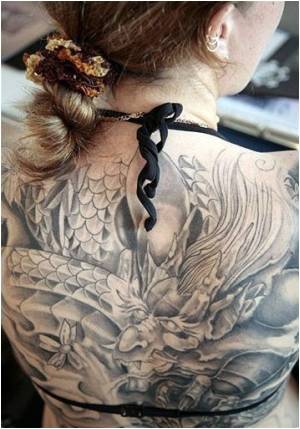The passion among Russians to decorate the body with tattoos is dated back to centuries. This age-old art is becomimg more and more popular with its new and distinct forms of expressions.
The growing popularity of body art in Russia was laid bare at a Moscow exhibition due to close on Sunday, at which the options ranged from tattooing to tongue splitting and mid-air suspension from hooks embedded under the skin.
"People are trying to become individuals," explained Olesya Crow, a local tattoo artist -- she uses only her commercial name -- among dozens of exhibitors at the Moscow International Body Art Festival.
"Society has become more tolerant and has developed. Tattoos are now a branch of art."
The setting of the festival, in an exhibition centre built to display Soviet agricultural and scientific prowess and dominated by a statue of Soviet leader Vladimir Lenin, might have appeared incongruous.
But Crow, who also takes part in human suspension, in which metal hooks are fixed under the skin of a person's chest, back or legs prior to hoisting them into the air, sometimes for hours, said her work represented social progress.
"Tattoos are now seen as something beautiful, an adornment of the body," as opposed to the stigma they carried in Soviet times, when they were associated with prisoners and crime, she said.
As for human suspensions, which Crow supervises, having undertaken four years of medical training, they "can have a healing effect, give a spiritual lift."
The growing popularity of body art in Russia was laid bare at a Moscow exhibition due to close on Sunday, at which the options ranged from tattooing to tongue splitting and mid-air suspension from hooks embedded under the skin.
"People are trying to become individuals," explained Olesya Crow, a local tattoo artist -- she uses only her commercial name -- among dozens of exhibitors at the Moscow International Body Art Festival.
"Society has become more tolerant and has developed. Tattoos are now a branch of art."
The setting of the festival, in an exhibition centre built to display Soviet agricultural and scientific prowess and dominated by a statue of Soviet leader Vladimir Lenin, might have appeared incongruous.
But Crow, who also takes part in human suspension, in which metal hooks are fixed under the skin of a person's chest, back or legs prior to hoisting them into the air, sometimes for hours, said her work represented social progress.
"Tattoos are now seen as something beautiful, an adornment of the body," as opposed to the stigma they carried in Soviet times, when they were associated with prisoners and crime, she said.
As for human suspensions, which Crow supervises, having undertaken four years of medical training, they "can have a healing effect, give a spiritual lift."













No comments:
Post a Comment